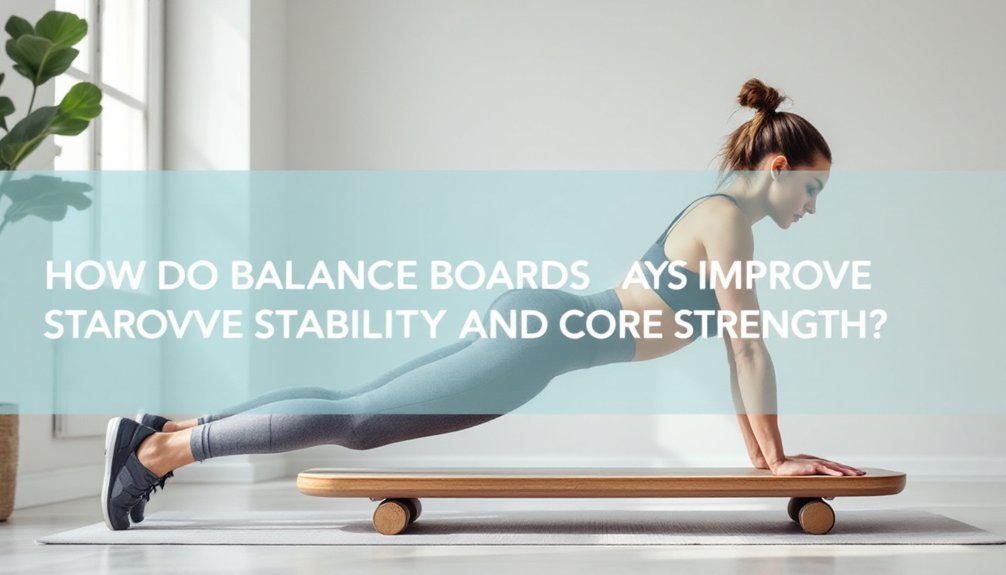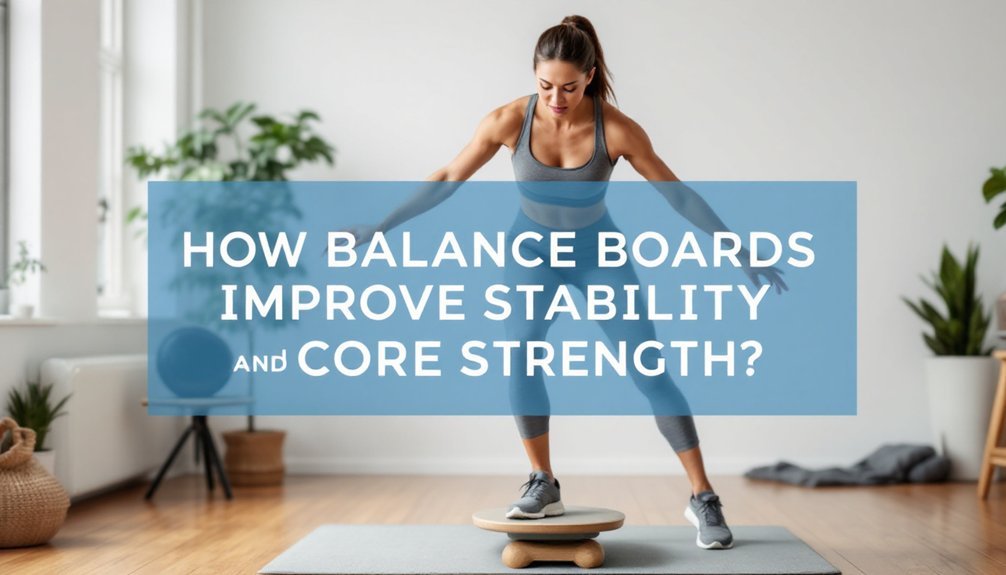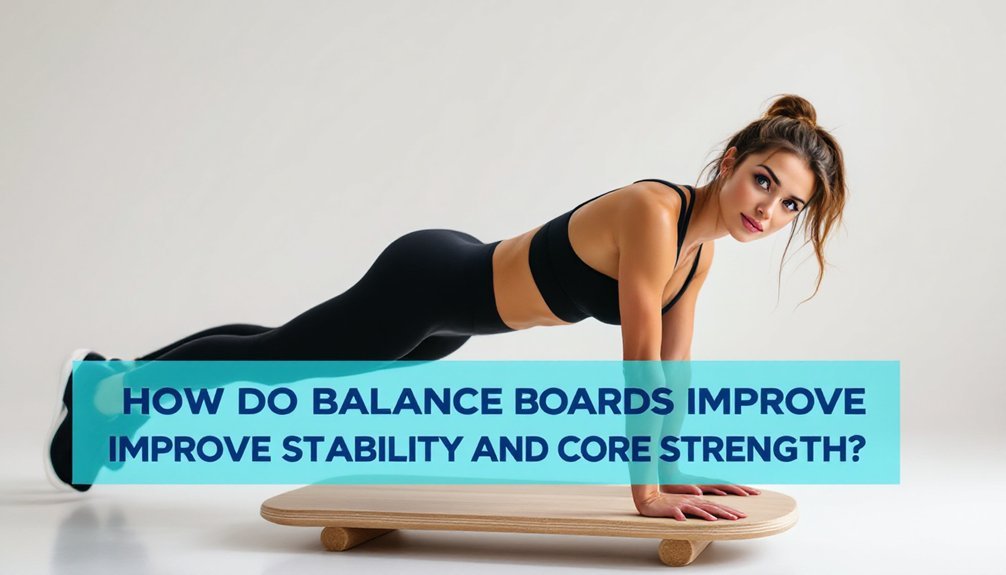Balance boards improve your stability and core strength by creating an unstable surface that forces your muscles to constantly adjust and engage. You'll activate deep core muscles, stabilizer muscles, and improve coordination while burning 14.2% more calories than sitting activities. The board challenges your ankles, knees, and hips through multiple angles, enhancing your overall balance and reducing injury risk. Starting with basic exercises like neutral stance and tilts, you can progress to more advanced movements such as single-leg balances and dynamic exercises. Understanding proper form and progression techniques will maximize your balance board's effectiveness.
Key Takeaways
- Balance boards create an unstable surface that forces multiple muscle groups to work simultaneously, enhancing overall stability and coordination.
- Regular use activates deep core muscles and stabilizer muscles throughout the body, leading to improved core strength.
- The constant need to maintain balance engages ankle, knee, and hip muscles, developing better joint stability and control.
- Progressive training on balance boards strengthens nerve-muscle connections, improving proprioception and reducing injury risk.
- Daily balance board exercises can burn more calories than sitting activities while developing functional strength and stability.
Understanding Balance Board Benefits

Four key areas make balance boards a valuable addition to any fitness routine: stability training, core strengthening, injury prevention, and overall fitness enhancement. While balance board history dates back to simple wooden designs, today's boards use advanced balance board materials like high-grade plastics and composites for durability and peak performance. Studies have shown that balance board exercises provide 14.2% more calories burned compared to sitting activities. Additionally, incorporating top fitness trackers into your routine can help you monitor your progress and stay motivated.
You'll find that these versatile tools improve your balance and posture by creating an unstable surface that challenges your body's equilibrium. They're particularly effective at engaging your core muscles, as you'll need to constantly adjust to maintain stability. Whether you're an athlete looking to enhance performance or someone recovering from an injury, balance boards can be adapted to your specific needs, making them an excellent investment for your fitness journey.
Key Balance Board Exercises
Mastering balance board exercises requires starting with foundational movements before progressing to advanced techniques. You'll want to begin with basic stability exercises, like maintaining a neutral stance for 30 seconds while performing gentle front-to-back and side-to-side tilts. Clear the surrounding area before starting any balance board workout to ensure safety during practice. Using a quality exercise mat can further enhance your comfort and stability while practicing these movements.
Once you've mastered basic stability, move on to core strengthening exercises. Start with single-leg balances, holding each position for 30 seconds, then progress to stabilizing planks with your hands on the board. You can challenge yourself further with lower body exercises, such as squats and lunges on the balance board. For maximum benefit, maintain proper form by keeping your spine neutral and engaging your core throughout each movement. Advanced users can incorporate dynamic movements like burpees and side plank rotations to enhance overall stability.
Muscle Groups and Development

When you step onto a balance board, your body immediately activates key stabilizer muscles, including your deep core muscles, hip stabilizers, and the small muscles around your ankles. These muscle groups work together in a coordinated effort, creating a chain of stability that runs from your feet through your spine, while progressively building strength through consistent practice. Your body's natural adaptation to the unstable surface leads to improved muscle activation patterns, helping you develop better balance and coordination over time. This low-impact exercise method helps reduce strain on joints while effectively targeting multiple muscle groups simultaneously. Incorporating resistance bands into your workout can further enhance the effectiveness of balance training by adding variable resistance to your movements.
Primary Stabilizer Muscles Activated
Balance board training activates essential stabilizer muscles throughout your body, especially in your core, legs, and ankles. Your abdominal and lower back muscles work together to maintain stability while you balance, improving your overall core strength and posture. This type of training has been shown to be more effective for back pain than conventional exercises.
When you're on a balance board, your ankle and leg muscles constantly engage to keep you steady. This muscle activation helps develop better coordination and reduces your risk of future injuries. You'll also notice your glutes and deep core muscles working harder than usual to maintain your balance.
The unstable surface of the board challenges your body's proprioception, forcing multiple muscle groups to work simultaneously. You'll develop stronger stabilizer muscles that help protect your spine, improve your balance, and enhance your athletic performance in daily activities.
Progressive Strength Development Patterns
The path to building strength on a balance board follows a natural progression as your muscles adapt and grow stronger. Through progressive overload, you'll notice improvements in your core stability, leg strength, and overall balance as your body adjusts to new challenges.
Your strength adaptation journey begins with basic stabilizer muscles engaging more effectively, followed by increased coordination between multiple muscle groups. Regular training helps target neglected core muscles for enhanced stability. You'll develop stronger abdominal and lower back muscles while your legs and ankles build foundational strength. As you advance, you'll notice improvements in your ability to maintain balance during more complex movements.
The process naturally enhances your functional strength by challenging your muscles in new ways. Your core, legs, and upper body will work together more efficiently, leading to better overall stability and improved performance in other exercises.
Starting Your Balance Training
Starting your journey with balance board training doesn't have to be intimidating. With these beginner tips, you'll quickly master the balance fundamentals needed for effective training. Begin by placing your feet hip-width apart on the board while maintaining an upright posture. You'll want to focus on a fixed point ahead of you, which helps stabilize your vision and improve your balance. Daily practice will help you achieve the best results in your balance training.
For your first sessions, position yourself near a wall for support and aim to maintain balance for 30-second intervals. As you get comfortable, slowly shift your weight between your feet to prevent the board's edges from touching the ground. Remember to engage your core throughout each exercise, as this is crucial for improving stability and overall performance. Don't hesitate to take breaks when needed. Progress at your own pace, and you'll build a strong foundation for more advanced movements.
Injury Prevention and Recovery

When incorporating balance boards into your fitness routine, you'll gain essential protection against common athletic injuries while accelerating recovery from existing ones. Balance training strengthens the muscles around your joints and improves your body's ability to sense its position, making injury prevention more effective. Practicing movements in multiple ankle angles helps develop comprehensive flexibility and stability. Additionally, the use of probiotics and prebiotics can further enhance your overall gut health, which may support your physical performance.
Your rehabilitation strategies will benefit from balance board exercises as they help rebuild weakened connections between your nerves and muscles. You'll notice improved stability in your ankles, knees, and hips, while your reflexes become sharper and more responsive. Clinical studies have shown that regular balance training can greatly reduce your risk of future injuries, especially if you've been hurt before. The key is consistent practice, which enhances your neuromuscular control and breaks the cycle of repetitive injuries.
Building Core Strength Effectively
You can build core strength through simple daily routines that incorporate balance board exercises, starting with basic movements like standing and progressing to more challenging positions. Your core muscles will respond best to a gradual increase in difficulty, which means adding new exercises and extending duration as you become more comfortable with each movement. Physical therapists have found that balance board training is highly effective for rehabilitation of lower leg injuries. When you're ready to advance your training, try combining balance board exercises with traditional strength movements, such as squats or planks, to maximize your core engagement and overall stability gains.
Core-Engaging Daily Routines
Building core strength effectively doesn't require expensive equipment or complicated routines, as many daily activities already engage these essential muscles. From walking to climbing stairs, your core muscles work continuously to maintain stability and posture. Recent lifestyle changes have made it crucial to focus on deep core stability during daily activities. You'll find natural core engagement opportunities in everyday tasks when you focus on pulling your belly button toward your spine.
| Activity | Core Engagement Tips |
|---|---|
| Walking | Maintain upright posture, engage abs |
| Climbing Stairs | Keep core tight, breathe steadily |
| Housework | Bend from hips, not back |
| Yard Work | Use core to power movements |
To maximize these daily activities, remember to maintain proper posture and breathing. You can enhance your routine by incorporating simple exercises like marching or seated core work, which don't require special equipment but effectively strengthen your core muscles.
Progressive Strength Training Methods
To achieve lasting core strength gains, progressive overload training offers a systematic approach that challenges your muscles in new ways. You'll want to focus on gradually increasing the difficulty of your balance board exercises through strategic resistance training and strength progression methods. Standard tempo training for balance board exercises involves 1-2 seconds for each movement phase.
Start by mastering basic balance board stances, then progress to more challenging variations like mini squats or planks. You can increase the intensity by extending your hold times, reducing rest periods, or adding weighted elements to your routine. For example, you might begin with 30-second basic balance holds, then advance to 60-second holds with arm movements. As your stability improves, incorporate more dynamic movements and combine multiple exercises to create compound movements that target different muscle groups simultaneously.
Advanced Balance Board Techniques

While many fitness enthusiasts start with basic balance board exercises, advanced techniques can dramatically enhance your stability and core strength. As balance board history shows, these devices have evolved from simple rehabilitation tools to sophisticated training equipment, reflecting the balance training evolution in modern fitness.
You'll find advanced techniques like twisting lunges and single-leg balances particularly effective for building lower body strength. When you're ready to challenge yourself further, try mountain climbers or planks on your balance board to intensify core engagement. These exercises don't just work your muscles; they improve your proprioception, which is your body's ability to sense its position in space. For ideal results, you should integrate these advanced moves into 10-15 minute daily sessions, always maintaining proper form and control.
Frequently Asked Questions
How Long Should Beginners Practice on a Balance Board Each Day?
Start with 10-20 minutes of daily practice, broken into 30-second to 1-minute intervals. You'll want to keep your beginner duration shorter while your body adapts to balance training.
Can Balance Boards Help With Specific Sports Like Surfing or Skateboarding?
You'll find balance boards highly effective for improving both surfing techniques and skateboarding skills, as they strengthen core muscles, enhance balance, and help develop the muscle memory needed for these sports.
Are Balance Boards Safe for Elderly People to Use?
Yes, you can safely use balance boards for elderly fitness with proper precautions. Start with stabilizer rings, maintain supportive surroundings, and progress gradually under professional guidance to guarantee balance board safety.
Which Type of Balance Board Is Best for Rehabilitation?
You'll find foam or BOSU balance boards most suitable for rehabilitation techniques, as they're gentler and more stable. Choose board variety based on your specific recovery needs and therapist's recommendations.
Do Balance Boards Help With Chronic Lower Back Pain?
You'd think standing on a wobbly board would worsen back issues, but balance training actually helps reduce chronic pain through improved core stability and muscle control during daily activities.



